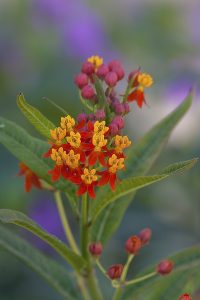by Renate Sander-Regier

Although it looks beautiful, Tropical Milkweed (Asclepias curassavica) may poison Monarch caterpillars. Photo by Adam Rodriguez (see NC State)
As though they are not already struggling enough (see Threats), Monarch butterflies now face an additional challenge. This new one, ironically, is linked to milkweed planting efforts!
It turns out that the various species of milkweed – the plant where Monarch butterflies lay their eggs, the only plant the larvae can eat for their development, and the plant many people throughout North America are cultivating to save the Monarch butterfly – are not created equal. Some of the differences lie in the toxic chemicals (cardenolides) produced in the plant’s leaf tissue.
Monarchs have evolved to tolerate those chemicals to a certain degree. When the caterpillars eat milkweed leaves, they ingest the chemicals and become unappetizing to predators. It is a great survival strategy. But when levels of cardenolides rise, the strategy can backfire.
That is the problem with one milkweed species in particular: tropical milkweed or blood flower (Asclepias curassavica), which is native to South America and apparently popular in garden stores throughout the southern United States. This attractive and easy-to-grow species offers numerous attributes, including higher levels of cardenolides which help butterflies gain more weight and increase their chances of survival.
But experiments conducted by Louisiana State University researchers reveal that warmer conditions can boost cardenolides in Asclepias curassavica to levels where caterpillars feeding on the leaves risk unintentionally poisoning themselves. Milkweeds native to North America apparently do not react the same way to warming.
It is feared that the widespread cultivation of Asclepias curassavica in the southern United States (so extensive that some are considering it an invasive species), along with warmer conditions caused by climate change, may combine to deal Monarch butterflies another serious blow. As if that were not enough, tropical milkweed has also been associated with a crippling parasite.
We can breathe a sigh of relief in the Eastern Ontario-Outaouais region, because Asclepias curassavica does not grow easily here. But the overall situation is worthy of attention because it illustrates the potential problems associated with non-native (potentially invasive) plants, the benefits of cultivating regionally native species, and the need to be precise about the identity of plants we are purchasing.
For regional sources of native plants, check out our website.
More information
For more information about tropical milkweed (Asclepias curassavica), Monarch butterflies, and related problems:
- It’s an ecological trap provides an overview of the Louisiana State University research.
- Climate change and an invasive, tropical milkweed: an ecological trap for monarch butterflies is the article published by the Louisiana State University researchers.
- Asclepias curassavica offers a profile of the tropical milkweed plant.
- Plan to save monarch butterflies backfires summarizes the threat of the crippling parasite associated with tropical milkweed.
- Tropical milkweed – a no grow? Xerces Society
- MonarchWatch Biology and Project Monarch Health provide details about the crippling parasite.
Renate Sander-Regier has a passion for wild bees. She seeks to encourage them and other native pollinators in different habitat planting projects – at her rural home, the Fletcher Wildlife Garden, the University of Ottawa campus, and more.
Hello Renate,
Thanks for you article ‘Milkweed muddle’. It was an eye-opener for me.
I had recently germinated some Milkweed seeds from McKenzie, only to find later that the back of the package said Tropical milkweed. This prompted me to research on the various species, and came across your article. I now know that the Tropical milkweed is harmful for Monarchs.
I live in Ottawa, so thankfully it will not survive our winter. I had shared my seedlings with a friend, before I had read your article. I have now forwarded your article to her.
Thank you kindly.
Suja
[An excellent and informative article on locally native milkweeds] https://1000islandsmastergardeners.ca/2025/08/15/ontario-milkweeds/